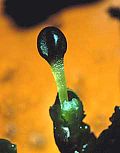Marchantiophyta
Marchantiophyta is a division of non-vascular land plants commonly referred to as liverworts. Along with mosses and hornworts, liverworts are part of the group known as bryophytes. Liverworts are small, green, terrestrial plants, often found in moist habitats, where they play a crucial role in the ecosystem. They are considered to be among the earliest plants to have evolved on land.
Characteristics[edit]
Marchantiophyta are characterized by a gametophyte-dominant life cycle, where the multicellular gametophyte is the primary phase of the life cycle, and the sporophyte is often ephemeral and remains attached to the gametophyte. Liverworts can reproduce both sexually, through the production of spores, and asexually, via fragmentation or the production of specialized structures known as gemmae.
The body of a liverwort is typically flattened and is called a thallus. In some species, the thallus is leafy, with leaves arranged in two or more ranks. The thallus is anchored to the substrate by hair-like structures called rhizoids. Liverworts lack true roots, stems, and leaves, which are characteristic of higher plants.
Classification[edit]
The Marchantiophyta division is divided into three classes: Marchantiopsida, Jungermanniopsida, and Haplomitriopsida. These classes encompass a diverse range of species, with Marchantiopsida being the most complex, featuring species with a more differentiated thallus.
Ecology[edit]
Liverworts are found worldwide, from tropical to arctic regions, inhabiting a wide range of environments. They are particularly abundant in moist, shaded areas, such as forests floors, rocks, and stream banks. Liverworts play a significant role in soil formation and stabilization, as well as in the water cycle, by retaining moisture in their habitats. They also provide a critical habitat for a variety of microorganisms.
Economic Importance[edit]
While liverworts are not commonly used in modern agriculture or medicine, some species have been used in traditional medicine practices for their antimicrobial and anti-inflammatory properties. Additionally, liverworts are studied for their potential in biotechnology and environmental monitoring, as they can be sensitive indicators of environmental changes, such as air and water pollution.
Conservation[edit]
Many liverwort species are sensitive to habitat destruction and pollution, making them vulnerable to environmental changes. Conservation efforts are important to protect these ancient plants, which contribute to the biodiversity and ecological balance of their habitats.
See Also[edit]
References[edit]
<references group="" responsive="1"></references>
-
Marchantiophyta
-
Marchantiophyta
-
Marchantiophyta
-
Marchantiophyta
-
Marchantiophyta
-
Marchantiophyta
-
Marchantiophyta
-
Marchantiophyta
-
Marchantiophyta
-
Marchantiophyta
-
Marchantiophyta
Ad. Transform your life with W8MD's Budget GLP-1 injections from $75


W8MD offers a medical weight loss program to lose weight in Philadelphia. Our physician-supervised medical weight loss provides:
- Weight loss injections in NYC (generic and brand names):
- Zepbound / Mounjaro, Wegovy / Ozempic, Saxenda
- Most insurances accepted or discounted self-pay rates. We will obtain insurance prior authorizations if needed.
- Generic GLP1 weight loss injections from $75 for the starting dose.
- Also offer prescription weight loss medications including Phentermine, Qsymia, Diethylpropion, Contrave etc.
NYC weight loss doctor appointmentsNYC weight loss doctor appointments
Start your NYC weight loss journey today at our NYC medical weight loss and Philadelphia medical weight loss clinics.
- Call 718-946-5500 to lose weight in NYC or for medical weight loss in Philadelphia 215-676-2334.
- Tags:NYC medical weight loss, Philadelphia lose weight Zepbound NYC, Budget GLP1 weight loss injections, Wegovy Philadelphia, Wegovy NYC, Philadelphia medical weight loss, Brookly weight loss and Wegovy NYC
|
WikiMD's Wellness Encyclopedia |
| Let Food Be Thy Medicine Medicine Thy Food - Hippocrates |
Medical Disclaimer: WikiMD is not a substitute for professional medical advice. The information on WikiMD is provided as an information resource only, may be incorrect, outdated or misleading, and is not to be used or relied on for any diagnostic or treatment purposes. Please consult your health care provider before making any healthcare decisions or for guidance about a specific medical condition. WikiMD expressly disclaims responsibility, and shall have no liability, for any damages, loss, injury, or liability whatsoever suffered as a result of your reliance on the information contained in this site. By visiting this site you agree to the foregoing terms and conditions, which may from time to time be changed or supplemented by WikiMD. If you do not agree to the foregoing terms and conditions, you should not enter or use this site. See full disclaimer.
Credits:Most images are courtesy of Wikimedia commons, and templates, categories Wikipedia, licensed under CC BY SA or similar.
Translate this page: - East Asian
中文,
日本,
한국어,
South Asian
हिन्दी,
தமிழ்,
తెలుగు,
Urdu,
ಕನ್ನಡ,
Southeast Asian
Indonesian,
Vietnamese,
Thai,
မြန်မာဘာသာ,
বাংলা
European
español,
Deutsch,
français,
Greek,
português do Brasil,
polski,
română,
русский,
Nederlands,
norsk,
svenska,
suomi,
Italian
Middle Eastern & African
عربى,
Turkish,
Persian,
Hebrew,
Afrikaans,
isiZulu,
Kiswahili,
Other
Bulgarian,
Hungarian,
Czech,
Swedish,
മലയാളം,
मराठी,
ਪੰਜਾਬੀ,
ગુજરાતી,
Portuguese,
Ukrainian











